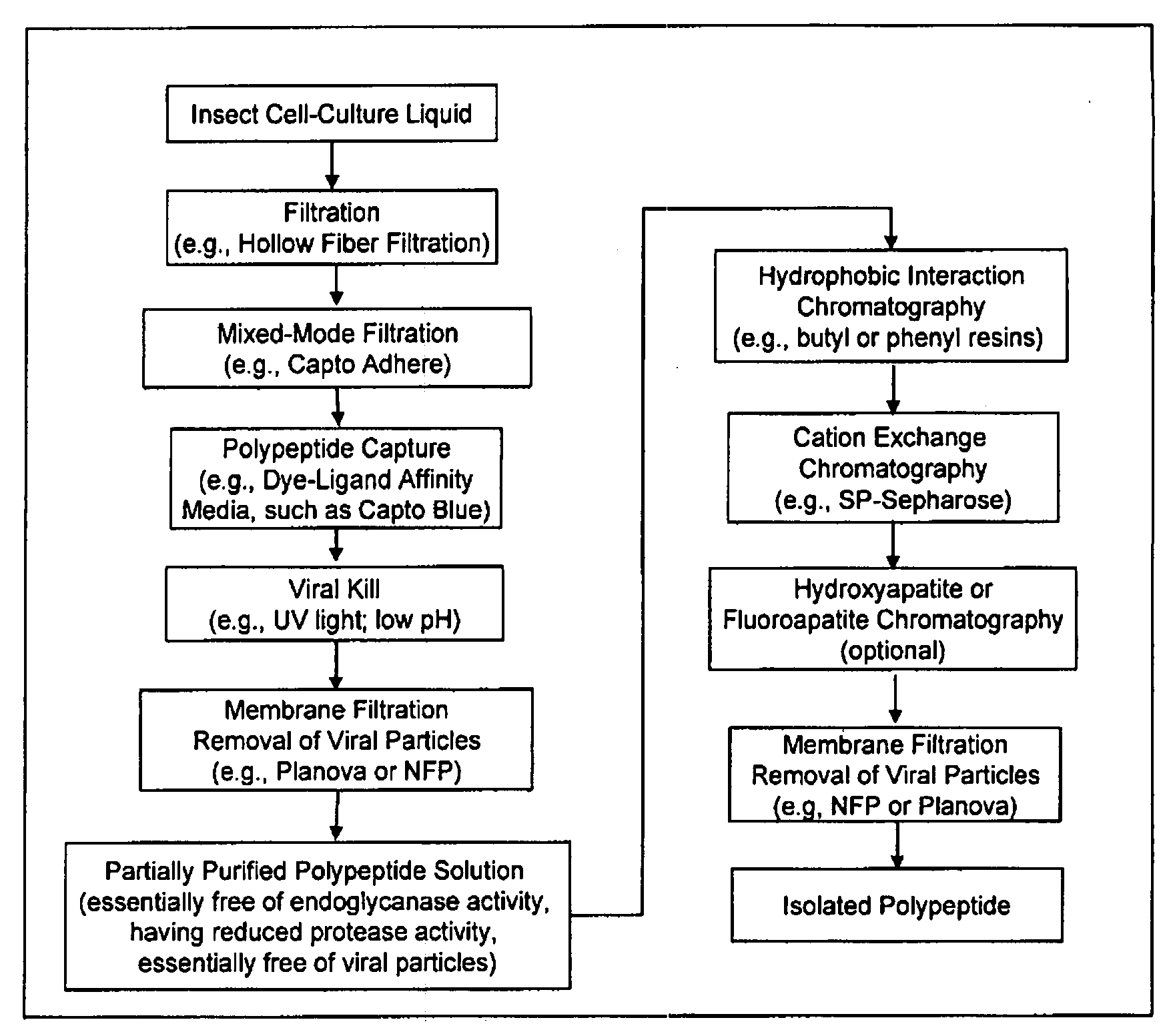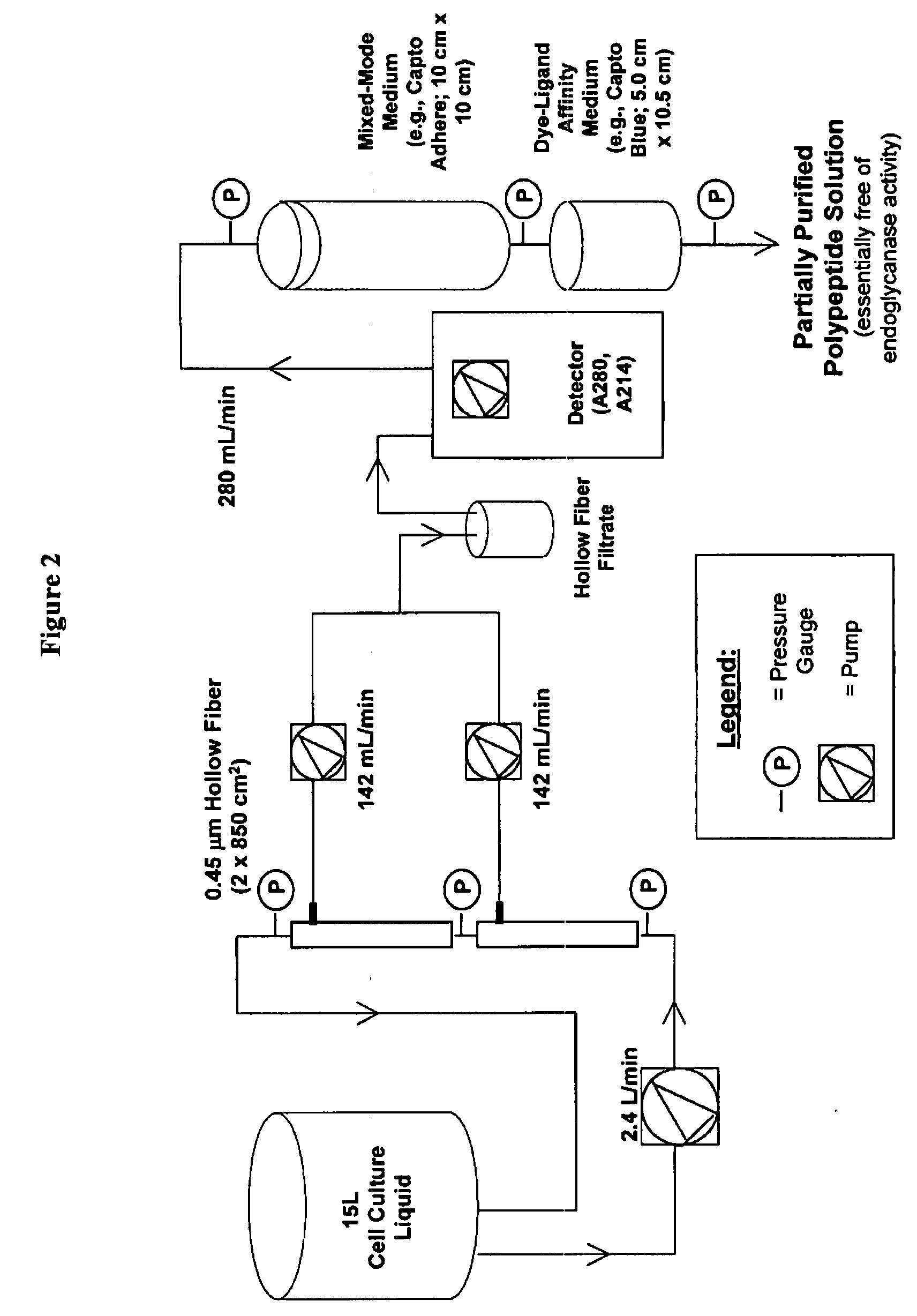Manufacturing process for the production of polypeptides expressed in insect cell-lines
a polypeptide and cell line technology, applied in the field of polypeptide manufacturing, can solve the problems of inability to provide polypeptides in bacterial cells, insoluble heterologous proteins produced in i>e. coli /i>, and low growth rate, so as to improve the overall recovery of active polypeptides, reduce manufacturing costs, and isolate quickly
- Summary
- Abstract
- Description
- Claims
- Application Information
AI Technical Summary
Benefits of technology
Problems solved by technology
Method used
Image
Examples
example 1
Determination of Endoglycanase Activity
[0312]Samples to be analyzed for endoglycosidase (endoh activity) were diluted 1:1 with glycerol, vortexed and optionally stored at −20° C. to preserve activity prior to analysis. The total sample volume ranged from 8 to 80 mcL, but was typically 40 mcL. The samples were buffer exchanged into 50 mM MES, 50 mM NaCl, pH 6.0 using 10,000 MWCO regenerated cellulose spin filters in a 96 well format. The samples were transferred to a 96-well filter plate and diluted to 300 mcL with 50 mM MES, 50 mM NaCl, pH 6.0 buffer, and centrifuged to near dryness (3000 g, 2×90 min). A second wash was performed by reconstituting with 100 mcL of the same buffer and then centrifuging to near dryness (3000 g, 90 min). The samples were re-diluted with 50 mM MES, 50 mM NaCl, pH 6.0 buffer to a volume of 80 mcL.
[0313]EPO substrate, 20 mcL at 1 mg / mL, was then added and the samples were incubated at 30° C. for 18 hours. After incubation, NA2 (asialo, galactosylated, bian...
example 2
Determination of Proteolytic Activity
[0315]Proteolytic activity in EPO fermentation and process samples was determined using an assay described by Slack er al. (J. Gen. Virol. 1995, 76, 1091-1098) or modified versions thereof. EPO process samples were diluted with water to a final volume of 300 mcL (typically 3 parts sample: 1 part water; but as high as 1 part sample: 9 parts water for samples with a high protease content). A series of aqueous dilutions for an EPO harvest reference control sample were also prepared (100%-3%). Diluted samples and controls (60 mcL) were added to individual wells of 384 deep well microplates in duplicates containing 60 mcL of 200 mM sodium citrate, pH 5.4, 6 M urea, 10 mM EDTA, 10 mM cysteine (mock reactions) or 60 mcL of 200 mM sodium citrate, pH 5.4, 6 M Urea, 10 mM EDTA, 10 mM cysteine with 0.4% azocasein that had been warmed to 32° C. Plates were sealed and inverted 6 times to mix the contents. The plates were centrifuged briefly (1000×g, 10 sec, r...
example 3
Polypeptide Harvest and Capture from Insect Cell Culture Liquid
[0317]In this experiment, insect cell culture liquid at 67 hours post-infection was clarified by pumping the bioreactor contents directly onto two 0.45 micron hollow fiber cartridges. The feed stream was concentrated approximately 10-fold and the retentate was diafiltered with two diavolumes to maximize polypeptide recovery. The hollow fiber permeate stream was loaded in real time onto two chromatography columns connected in series. The first column included a mixed-mode anion exchange filtration medium (Capto Adhere). The second column contained an affinity capture resin (Capto Blue). At the conclusion of the filtration, the columns were washed with low conductivity buffer and the Capto Adhere column was disconnected and removed. The polypeptide was then eluted from the Capto Blue resin with 2 M KCl in a phosphate buffer at pH 7.0. This process when performed at a 15 L fermentation scale, resulted in a 45-55% recovery o...
PUM
| Property | Measurement | Unit |
|---|---|---|
| Fraction | aaaaa | aaaaa |
| Fraction | aaaaa | aaaaa |
| Fraction | aaaaa | aaaaa |
Abstract
Description
Claims
Application Information
 Login to View More
Login to View More - R&D
- Intellectual Property
- Life Sciences
- Materials
- Tech Scout
- Unparalleled Data Quality
- Higher Quality Content
- 60% Fewer Hallucinations
Browse by: Latest US Patents, China's latest patents, Technical Efficacy Thesaurus, Application Domain, Technology Topic, Popular Technical Reports.
© 2025 PatSnap. All rights reserved.Legal|Privacy policy|Modern Slavery Act Transparency Statement|Sitemap|About US| Contact US: help@patsnap.com



